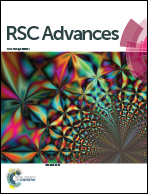Fabrication of tungsten nanocrystals and silver–tungsten nanonets: a potent reductive catalyst†
Abstract
This communication reports the first synthesis of well-defined colloidal W nanocrystals, Ag–W heterostructures and their broad plasmon absorbance in the visible to near infrared region. Strong interparticle plasmonic interactions significantly improve the photocatalytic reduction performance of silver–tungsten heterostructures.


 Please wait while we load your content...
Please wait while we load your content...